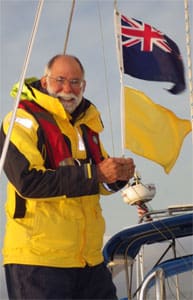Clearing into and out of countries can be as simple as the waltz or as complicated as the tango, but it is always a memorable experience. We recently received an email from a boating friend who was very concerned about the process of gaining entry into a foreign country by boat. He said he had heard “horror stories” about it and had made the choice not to go out of the country for that very reason. What a mistake he is making! We have legally cleared into and out of 30 countries in the last six years and though there have been a few challenges, we have never had a “horror story” experience.
Here are a few things we’ve learned about the process over the years. We personally enjoy putting up that new country’s courtesy flag and the yellow “Q” flag, as well as the experience of going through the clearance process. It is your first impression of the country and its people — it is always revealing.
Know before you go
With the ease of research provided by Internet today, there is no excuse for not knowing what is required before entering a foreign port. You should do your homework well in advance and then double-check that things haven’t changed right before you go. Much depends on which country’s passport you hold, as the rules are often very different for various nationalities and the agreements the countries have with each other. We carry U.S. passports and that has made most countries quite easy — though for a few we wished we were members of the European Union. Some important things to check out:
• Do you, or does anyone that will be on board with you as crewmembers or guests, need a visa prior to entering by boat? If so, gather the forms and start your process as soon as you can, as there may be delays.
• Do you need to give advance notice of your arrival? This is happening in more countries. The country requires notification that you will be arriving by boat and the details of your crew and vessel, port you will be arriving into and the approximate date of your arrival. Most of the countries allow you to do this via email and you should get some response that it has been received. Some countries have specific forms you must fill out and submit in advance.
• What are the ports you are allowed to enter when first arriving, and what are the rules about stopping within the country prior to your arrival at that port of entry?
• How long will you be allowed to stay? And will the timing work out for when you will be required to leave (e.g., will you be clear of hurricane/cyclone seasons)?
• How long will your boat be allowed to stay without paying import fees? It can be different for individuals and your vessel. For example, in Fiji a U.S. citizen can stay six months, but the boat can stay 18 months without paying import tax.
• What are the costs, and can you clear in on weekends or after normal working hours? If so, what are the overtime fees? To make any payments, can you get the local currency after arriving or do you need to have it upon arrival?
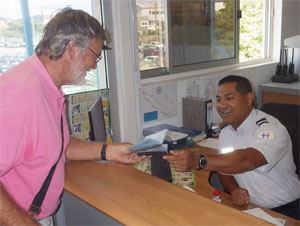 |
|
Hawkins checks into New Caledonia. |
The more you know in advance, the fewer surprises you will have. Besides the government sites for the country you are planning to visit by boat, be sure to also check out what other cruisers have to say about the process. There are lots of sites that provide great information about this and you can read many boaters’ logs about their personal experience. One word of warning about this, though: Know the source, or seek out multiple experiences. We personally know of one cruiser who really bad-mouthed a country for his experience with the clearance process. But as they say, there are two sides to the story! He seemed to be trying to skirt the proper procedures and was rude to the officials when caught. It’s no wonder he had issues, but he doesn’t share that side of the story. Also be sure the information you are getting is current. For example, when we were recently in Vanuatu, midway through our stay the rules about advance notification were changed so boats that had cleared in earlier in the season had one experience and, if shared, it would have been incorrect information.
Their rules
When in a new country the best advice is to remember that it is their country, their rules. You may think a particular rule isn’t the most efficient or expedient way to do something and it may be totally foreign to your way of thinking, but it is their way of doing it. Accept that and you’ll enjoy the experience much more. Don’t let the system frustrate you. Go with the flow! Most of the officials we have met are very proud of their country and try to give you a warm welcome to their land. You smile and they’ll most likely smile back. Treat them with respect and you’ll be treated likewise.
We always ask lots of questions — specific questions about the check-in process, as well as social questions like how many children they have and what is their favorite restaurant locally. It helps break the ice and establish that you are also interested in them and their country.
Officials on your boat
By doing some checking with other boaters, you’ll find out if you must put your boat in a certain area upon arrival. In New Zealand, for example, there are specific “Q” docks and in many countries there are designated anchorages for vessels while they await “pratique.” Before entering the country’s waters, you should put up your yellow “Q” flag and a courtesy flag for the country you are visiting. The proper order on your starboard flag halyard is the country flag on top with the “Q” flag beneath it.
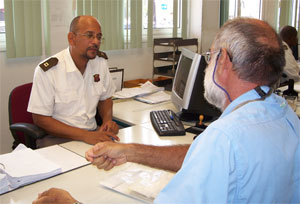 |
|
Meeting with a customs agent from Curacao. |
Many countries require permission to enter the main port. You must make a VHF call to the port authorities (sometimes called Port Control or Harbor Control). This contact will also help establish what the proper procedure is for you to enter that country. In some ports however, you’ll actually have to figure out on your own what you need to do. SSB radio nets, other boaters and research in advance should help you know what is to be expected.
In most cases, we have had to go to shore for clearance, though in at least five countries, we have had the officials on board for the process. In Kiribati, we actually had to get our dinghy inflated and launched in order to go pick up the five officials from shore. When we do have them on board, we always treat them as guests on board and offer a cold drink or coffee and a snack.
If it’s a holiday or weekend, be prepared to have to wait aboard until a workday or pay overtime fees. Each country has specific rules for this. Always try to plan your arrival, if possible, within normal working days and hours to save the hassle of extra fees. We have slowed down a passage at the end for a weekday arrival.
Going to them
If the officials don’t come to your boat, you’ll have to go to them. Most countries have multiple places you’ll have to visit to complete your clearance process — quarantine, customs, immigration, health, biosecurity, police chiefs and others. Many countries have an exact order that must be followed as to whom you see first, second, third, and so on. Do some checking to save some footsteps by asking other boats where you go first. In Los Roques, Venezuela, we were told the order of the six stops we had to make, but then that got changed midway because the third stop (the park office) wasn’t available, so we got permission to juggle the order! The island is relatively small so the walking wasn’t too bad, and it was a fun adventure nonetheless as all six offices pulled out the same multi-columned book to write the exact same information in each. Now that was clearance “by the book!” In Curacao, we got in a good hike as we had to cross a bridge and back to get all our paperwork properly completed.
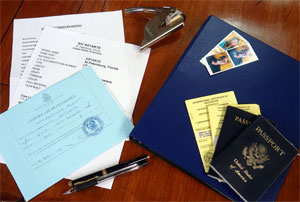 |
|
A “clearance pack” that Hawkins and Barbara Sobocinski have put together with documents and frequently requested data for their Moody 442 Astarte. |
Paperwork, paperwork, paperwork
The clearing in and out process means paperwork … and sometimes lots of it. We have a binder with all our paperwork to make the process as simple as possible. This includes many copies of everything; we have a printer on board and always make sure we have at least 10 copies of all our paperwork in the binder. The copies of paperwork we have include:
• Our current boat documentation
• Passport copies
• Crew lists
• Boat details — this is a form we have created and translated into Spanish and French as well. It has all the boat specifics including boat type, length, beam, depth, color, construction material, radio call sign, boat documentation number, home port, last port and next port and a crew list with passport numbers. We have the data in both feet and meters. Handing this piece to the official makes his or her job much easier as they complete much of the paperwork. This is especially true in ports where there is a language difference. We have had cruisers fluent in other languages help translate our form into both Spanish and French. It has paid off with the officials making their job simpler and we also look quite prepared.
In our binder we also have:
• Zarpe or clearance document from the last port (at least one copy of this for our records because your original will be taken by the new port)
• Our passports
• Yellow Health “book” (records of vaccines for yellow fever, etc., though we have never been asked for these)
Another piece of advice: Get passport photos taken before you leave and carry a dozen or so for each person aboard. Some countries require photos for either the visa or a permit of some type, and getting the photos taken on these small islands can be difficult or costly. When in Panama, we had a bunch made very cheaply and they have come in handy. In Vanuatu we needed two photos each for our immigration extension.
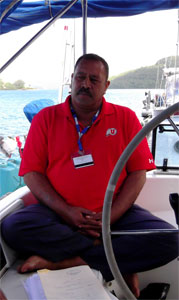 |
|
A customs agent in Fiji came aboard Astarte for the clearance paperwork. |
Always bring a spare pen and if you have a boat stamp, bring that — some countries love boat stamps to make things “official.”
Show respect
Aretha Franklin had it right. If you act right, you’ll get treated right. When we do the clearance dance, or whenever we go to a government office, we dress appropriately. The people in the office will often be in clean, pressed uniforms even in the tropics. We may not have ironed or starched shirts, but Michael always wears slacks and a collared shirt and Barbara is usually in a skirt or dress. In Grenada, because we were dressed and polite in a very busy office, we were seen well before others who were rude, impatient and dressed in tank tops and ratty shorts. So, it does pay off. Be patient and just consider it an adventure. Always remember you are a guest in this country — be a good one!
Dollars or vatus or pa‘angas
Some countries have no charges for clearance and others have fees for the various services. All the countries we have cleared into have allowed us to go and get the local currency to pay, rather than have it in advance. We always ask for receipts for all fees paid. Always! This sometimes cuts down on any fraudulent fees when you ask for an official receipt. We keep these so that there is never a question later as to what we owe.
An agent or D-I-Y
In some countries, using an agent is preferable. This is especially true if you are not fluent in that particular country’s language and/or it is a complicated process. We used agents in the Galapagos, Colombia and French Polynesia. The last we used to save the cost of a bond for the boat. In all these cases, we felt the agent was well worth the extra cost even though we are on a budget. In fact, having the agent for the Galapagos allowed us to go to the island of Isabella for our one-island, one-month permit. Most times, we prefer to do it ourselves and we rather enjoy the experience.
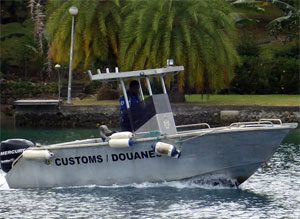 |
|
A customs boat moves through the anchorage in Vanuatu. |
Clean wake
With 30 country stamps in our passport since we started this cruise in 2009, we have always tried our best to represent the boating community well when entering and leaving these countries. It always makes it tough on the rest of us when one boater skirts the rules. That creates tougher rules, tougher enforcement and a distrust of boaters in general. Sometimes the rules may seem out of date or out of line, but it is their country — their rules.
Load up on those country courtesy flags. Find that “Q” flag. Have plenty of pages in your up-to-date passport. Get extra passport photos. Do your homework and get ready for the experience of a lifetime. Think of going to customs, immigration, biosecurity and the rest as part of the cruising adventure. It’s your introduction to each new country, make the best of it — it is worth it!
Barbara Sobocinski and Michael Hawkins live aboard their 1987 Moody 422, Astarte. They began voyaging in 2009 and are currently in New Zealand.

